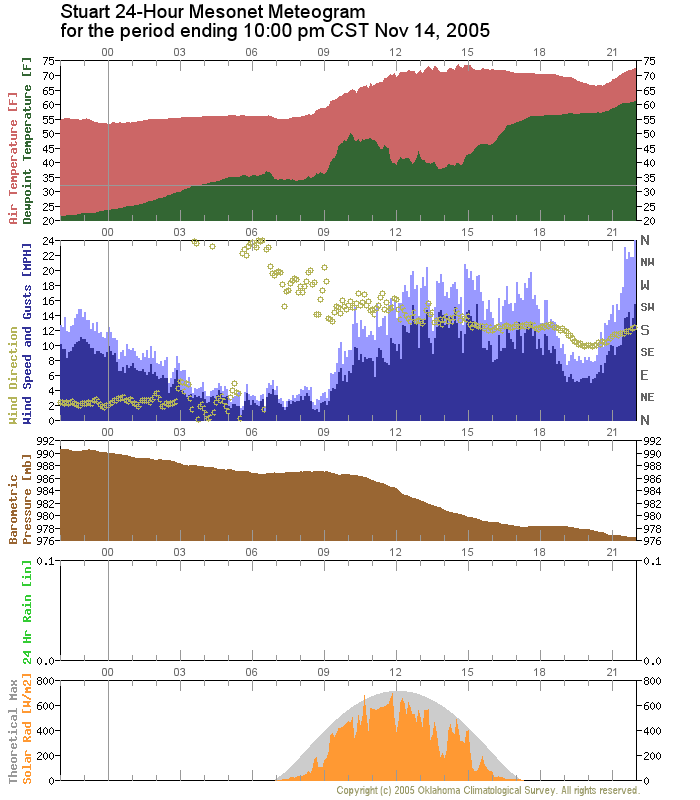Ticker for November 15, 2005
MESONET TICKER ... MESONET TICKER ... MESONET TICKER ... MESONET TICKER ...
November 15, 2005 November 15, 2005 November 15, 2005 November 15, 2005
A Powerful Ticker
Yesterday featured the dramatic (albeit brief) en masse return of
water molecules to much of Oklahoma. Acting on respect for the
slight chance that you were not glued to the 24-hour dewpoint
change map at 9:15 pm last night, here's a look:

That's right, by bedtime last night, the previous 24 hours had seen
dewpoints surge by as much as 40 degrees! The dramatic moisture return
was documented by the rising green bar in the Stuart meteogram:

This moisture return was vital to increasing the threat of severe
weather across parts of the state last night. How so? Well, adding
moisture to the bottom layer of the atmosphere (not to mention heating
it up) helps make it more energetic. Water vapor carries with it a
hidden - but substantial - investment by the sun. This "latent heat"
represents all of the energy that went into evaporating it. And it
takes a *lot* of energy to convert liquid water into water vapor ...
about 2.5 million Joules per kilogram of water.
And, if you let us do some hand-waving and assuming, here's an
example of how much energy the bottom part of the atmosphere gained
at Stuart yesterday ... (note to self: grab pencil and napkin and
cue Jeopardy music).
* The dew point temperature rose from about 22 to about 61 degrees
Fahrenheit.
* This represents a jump in mixing ratio from about 2.5 g/kg to
about 11.9 g/kg.
* For a 1000 meter deep "box" of air that covers a 200m by 200m
square (about 10 acres), the mass of water vapor in that box
increased from about 101,000 kg to about 469,240 kg ...
... this represents an additional 367,588 kg (about 405 tons!)
of water vapor
... Let's repeat that: By 9:15 pm last night, a ten-acre
patch of land near Stuart had more than 400 tons of water
vapor added to the atmosphere just above it. 400 tons!
* In order to evaporate 400 tons of water, one would need to
invest 918,969,793,237 Joules of energy.
* This converts to 255,269 kilowatt-hours.
In other words, the additional energy added - by the introduction of
water vapor alone - to a 1000-meter-deep "box" with a ten-acre
footprint near Stuart in twenty-four hours ...
... would power the average American household for 9.5 years.
November 15 in Mesonet History
| Record | Value | Station | Year |
|---|---|---|---|
| Maximum Temperature | 86°F | ARNE | 2016 |
| Minimum Temperature | 8°F | KENT | 1997 |
| Maximum Rainfall | 2.71″ | BROK | 2011 |
Mesonet records begin in 1994.
Search by Date
If you're a bit off, don't worry, because just like horseshoes, “almost” counts on the Ticker website!